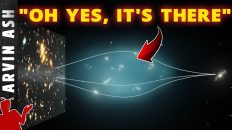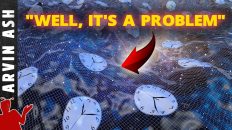The quantum physics of large things: Why don’t tennis balls behave like quantum particles?
If you’re watched any of my videos on quantum mechanics, you know that the smallest particles in nature, including photons, electrons, atoms, and even some molecules behave in strange ways.
You know that observation is synonymous with measurement. The double slit experiment shows that they behave like waves of probability when not measured, and quite strangely, when measured, these probability waves collapse so that they become distinct particles.
We also see from experiments like the delayed choice quantum eraser that two particles can be entangled, meaning that they appear to be somehow intimately connected through a sharing of one probability wave, even if the two particles are separated apart in space-time.
And this behavior seems really strange to us because this is not something that we observe in our macro world. But why is that? Why don’t we see this kind of strange and mysterious behavior in our everyday lives?
At what point does the quantum behavior stop and classical behavior of everyday objects begin, and why is there a cut off?
Scientists have shown quantum behavior in particles as large as molecules containing hundreds of atoms. These are very large particles and the experiments are not easy to carry out.
How large a particle can you get and still show quantum behavior. What if I take this tennis ball and throw it at a double slit with a screen behind it that records the position of the ball when it hits? What if I take thousands of baseballs and throw it at a double slit?
Will I see the same kind of behavior that electrons or atoms have?
No of course not. I will just see two patterns on the back wall. Why doesn’t this thing behave like electrons or atoms?
It’s made up of atoms and the electrons around it. 6 trillion trillion atoms. Why doesn’t the whole behave like the individual particles it is made up of?
To answer this, we have to understand some of the basics of quantum mechanics. Let’s look at how the double slit experiment works with electrons and atoms first.
Richard Feynman called this the central mystery of quantum mechanics. Let’s do the experiment with light first. The results are the same with electrons and atoms. When we shine a Monochromatic light, that is light of only one wavelength through two slits. As light hits screen, we see an interference pattern on the other side because as the waves spreads out, the crest of one wave hits crest of another, it become stronger, where a crest hits a trough, it will cancel. This should be no big mystery. This is not quantum mechanics, this is just a property of waves. It will happen with water waves too.
Now, what if we lower the intensity of the light and keep lowering it until our light source emits only one photon at a time. Surely this should not create wave patterns. When we shoot one photon at a time, it forms a dots on the screen, but if you fire enough of them, thousands or millions of photons, what you find is that collectively the photons form the same interference pattern. So somehow the photon either interacts with itself or somehow is able to contribute its part in the interference pattern, when fired one at a time.
So, since we want to find out what’s going at the slits, what if we put a detector there to determine whether the photon goes through slit one or slit two? This the most startling result of quantum mechanics, because whenever you try to find out which path the photon took, the interference pattern disappears. The photons appear to now behave like particles instead of waves.
So what’s going on? Let’s talk in the language of the Copenhagen interpretation which is the most accepted interpretation of quantum mechanics. This was conceived by Neils Bohr and Werner Heisenberg at the university of Copenhagen around 1927. This interpretation basically says that these so-called particles are not particles at all, but are really like clouds, they are in multiple states at the same time, they are like wave of probabilities.
The waves become distinct like particles only when they are measured. At the point at which the probability wave becomes a distinct particle is called a collapse of the probability wave.
What scientists have found is that at any point when the which-path information of any particle is measured, its probability wave collapses. For the particles to remain probability waves, their path information must remain in absolute secrecy. If at any point any kind of measurement is made, whether it seen by anyone or not, the particles become distinct and do not display wave like behavior.
This same behavior has been found in subsequent years with electrons, atoms, and even molecules composed of as many as about 800 atoms. The same interference pattern forms. And the same collapse occurs if their which-path information is measured.
A measurement always collapses the wave. So what is a measurement? A measurement is a formation of any physical record of which path the particle takes. It is not about conscious observers. It is about a record made in the universe even if no one is looking. It is such that a forensic exam if we had even the most sensitive quantum tools, could establish which path the particle took. You never have to look at the information. You can even destroy the information before you look at it, like burn it, or destroy the hard drive that it is on. The wave will still collapse, because the universe already recorded it. Why is it recorded even if you destroyed it? Because theoretically, you could go back in time and see the path. The universe will say, hey I already know the path. Now it’s a particle. You can’t have your wave back.
The path has to be taken in absolution secrecy. The particle has to be informationally isolated. The interference can only occur if it is impossible, even in principle, to find out which path the particle took.
But the Copenhagen interpretation is not the only interpretation. In Many worlds interpretation, this phenomenon would be described like this. At the point that measurement is being made – the measurement device and the photon became entangled together. The state of the universe branches in two. Your universe is the one where the wave collapsed, but there is another universe that you can’t see, where the wave continues as cloud of possibilities.
As I said, this happens with photons, electrons, atoms and even large molecules.
Now what if we do this with really large particles like grains of sand which, by the way, are typically composed of quintillions of atoms, or tennis balls. Do we see the same patterns? Of course not. We will just see two large mounds on the other side.
Why don’t we see this behavior with tennis balls? The reason is that large objects are nearly impossible to isolate informationally from the outside world. What do I mean by this?
Let’s look and see what it would take to isolate a tennis ball. Remember to do this, we have to make sure that there is no record made anywhere in the universe of which path the tennis ball follows.
First we have to remove all the air and photons in the experiment. Why? Because if a photon or air molecule bounces off the tennis ball, then it has potentially recorded the path of the tennis ball. The photon will do the same thing, if a photon reflects off of the ball, then that could be a measurement because the path of the photon would be changed and the bounced path of the photon has recorded the path information of the ball. Potentially, someone or the universe could examine the paths of all the photon in the room, find out how they were affected by the path of the tennis ball, and find out from that information, the path of the tennis ball.
We will also need to cool the baseball to near absolute zero, because the baseball that has a temperature will emit photons due to something called black body radiation. This is a property of all bodies with a temperature above absolute zero or -273 degrees celcius. These emitted photons will have recorded information about the tennis ball, such that someone examining the photons could determine the path of the tennis ball.
We even have to worry about the small amount of gravitation that the tennis ball will have. Why? Because this gravitation of the tennis ball will effect nearby atoms. This in principle can allow someone to determine the path the tennis ball took. So this ball will also somehow have to be isolated from that. These movements of nearby atoms can also form a record of the path of the tennis ball.
We have to completely isolate the tennis ball because any information that is leaked to the universe about its path will create a record. Even if this information is recorded in one atom, it is still information which has been captured in the universe, and the tennis ball will not be in superposition.
Macroscopic objects like this are very difficult if not impossible to isolate informationally. So in our everyday experience, we will not see quantum superposition or wave like behavior of macro objects. This is the reason, you and I and the cat in Schrodinger’s experiment are NOT in superposition. The cat is not dead and alive at the same time. That is a myth.
And there is no possibility of interference patterns being formed in our normal everyday interactions. And for the same reasons, macroscopic objects also cannot be entangled in the way photons can be entangled for example. So what we see macroscopically is a very different world than what we see microscopically. And this is why it is a mistake to extrapolate our observations and equations in quantum mechanics to our everyday experience. They behave in completely different ways. They are two different worlds.
Quantum mechanics is what happens when no one is looking. This is what makes it so mysterious. It’s as if it only happens when you are not allowed to look and find out how it happens.
Another way to look at this is that macro objects like tennis balls and humans are very intimately connected to the universe. Our every move and path and even thought is recorded in the particles around us and within us. In this way, all our whereabouts and even thoughts becomes part of the fabric of the universe. There is no escaping our intimacy with the forces and particle that we are made up of, and are surrounded by, and in this way we are at least informationally, indeed one with the universe.







